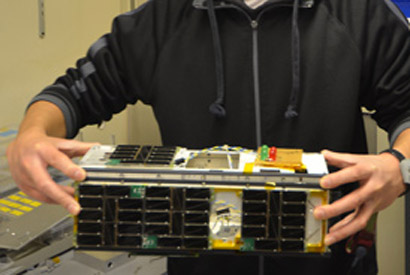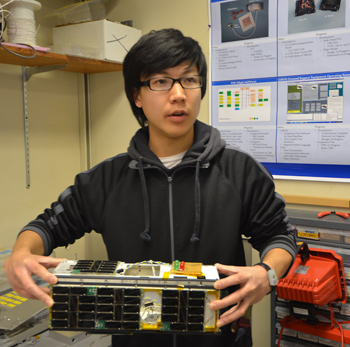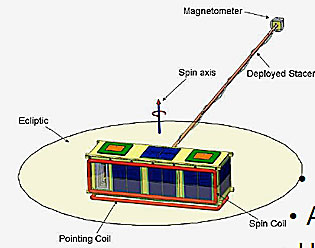CINEMA among tiny CubeSats to be launched Aug. 2
CINEMA, a tiny nanosatellite designed and built by students at UC Berkeley, is scheduled for launch on Aug. 2. Once in Earth orbit, it will monitor the movement of charged particles in the atmosphere that can disrupt power grids on the ground.

July 31, 2012
NOTE: After a six-week delay, the CubeSats were launched at 2:39 p.m. PDT Thursday, Sept. 13. UC Berkeley space scientists will try to contact the spacecraft later the same day.
BERKELEY – Eleven tiny satellites called CubeSats will accompany a spy satellite into Earth orbit on Thursday, Aug. 2, inaugurating a new type of inexpensive, modular nanosatellite designed to piggyback aboard other NASA missions.

Jerry Kim, a former student and systems engineer, holds the CINEMA nanosatellite before it was packaged up and sent to NASA in January 2012. Robert Sanders photo.
One of the 11 will be CINEMA (CubeSat for Ions, Neutrals, Electrons, & MAgnetic fields), an 8-pound, shoebox-sized package which was built over a period of three years by 45 students from the University of California, Berkeley, Kyung Hee University in Korea, Imperial College London, Inter-American University of Puerto Rico, and University of Puerto Rico, Mayaguez.
“This is a new way of doing space research, funded by the National Science Foundation with launch arranged by NASA,” said CINEMA principal investigator Robert Lin, professor emeritus of physics and former director of UC Berkeley’s Space Sciences Laboratory. “This is our first try, but if everything works, we’re going to get a lot of good science out of this.”
CINEMA will obtain images of the “ring current,” an electrical current that encircles the Earth and which, during large magnetic “space storms,” can blow out power grids on the ground. By next year, CubeSat will be joined by three identical satellites – two launched by Korea and another NASA-launched CubeSat – that together will monitor the 3-dimensional structure of the ring current and warn of dangerous activity.
Launch is set for just after midnight PDT this Thursday, Aug. 2, from Vandenberg Air Force Base in California. UC Berkeley scientists hope to communicate with the satellite as it passes over California around noon PDT, and get it into full operation by a week after launch.
CINEMA is one of five university-built CubeSats aboard the Atlas V rocket; the other six are military or commercial. The main payload is NROL-36, a classified satellite commissioned by the U.S. National Reconnaissance Office.
NASA’s CubeSat Launch initiative provides an opportunity for small satellite payloads to fly as auxiliary payloads on previously planned missions. The nanosatellites are made of cubes that are approximately four inches on a side, have a volume of about one quart, weigh about two pounds, and are meant to be grouped in twos or threes for a particular satellite. CINEMA, for example, is comprised of three cubes. Some two dozen CubeSats are built or under construction at universities alone, and these 11 are the first to go into orbit.

A diagram of the three-cube nanosatellite CINEMA, with its magnetometer boom deployed.
For three years, Lin has overseen the construction and testing of CINEMA, aided by 25 UC Berkeley science and engineering undergraduates and graduate students. For two summers and winter vacations, about 10 students from Korea came to SSL to assist, while 8 students from Puerto Rico came to Berkeley to help with the engineering.
“There is more risk with these projects, because we use off-the-shelf products, 90 percent of the work is done by students, and the parts are not radiation-hard,” he said. “But it is cheaper and has the latest hardware. I will be very impressed if it lasts more than a year in orbit.”
The spacecraft carries a new instrument, STEIN, which detects energetic neutral atoms (ENAs) to produce an image of the high-energy charged particles in Earth’s atmosphere, mostly ionized hydrogen and oxygen. This is possible because ionized particles, which spiral around magnetic field lines surrounding Earth, occasionally hit a neutral particle and grab an electron, transforming themselves into ENAs that travel in a straight line. These energetic neutral atoms can be imaged to reveal the energy and location of the charged particles from which they came.
“It’s like astronomy, but using neutral particles instead of light to create an image,” Lin said.
STEIN, with 32 particle detectors fabricated by Lawrence Berkeley National Laboratory, is equipped with electronics miniaturized by a group (CEA Saclay) in Paris so as to fit into the same space as four of Lin’s earlier detectors and use one-thirtieth the power. CINEMA also carries the MAGIC (MAGnetometer from Imperial College) instrument, provided by Imperial College London, to measure changes in Earth’s magnetic field caused by magnetic storms, as well as provide vital information about the orientation of the satellite as it orbits Earth.
Lin and his SSL colleagues, including research physicist Thomas Immel and grad student John Sample, will communicate with CINEMA through the lab’s Mission Operations Center and Ground Station, a radio dish in the Berkeley hills.
For more information about the students working on the project, link to an October 2011 UC Berkeley NewsCenter story.
RELATED INFORMATION